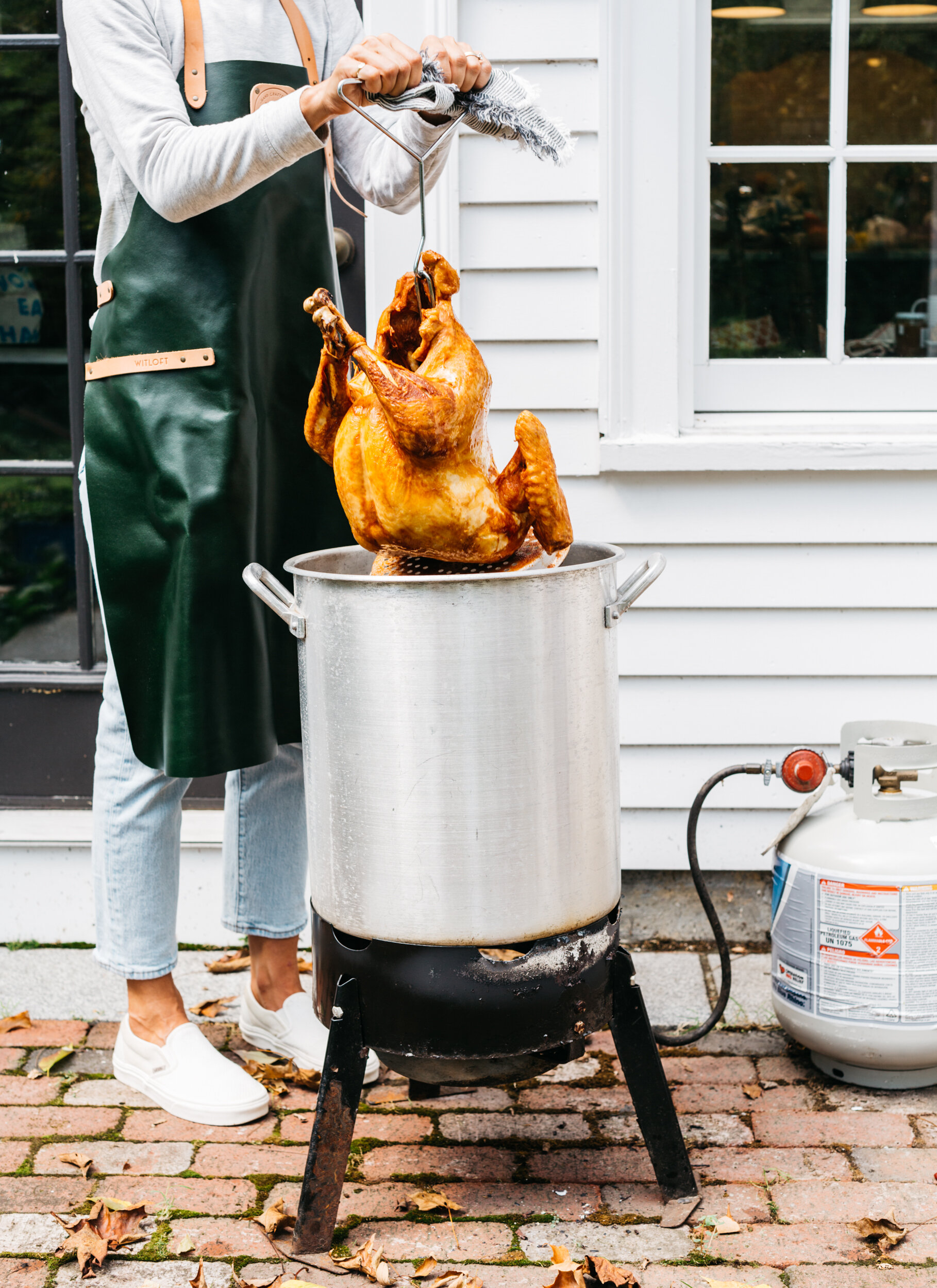Deep-Fried Judy Bird with Thyme Gravy
Photos by Michael Piazza / Styled by Catrine Kelty
Chef Judy Rodgers was the embodiment of California cooking—employing simple techniques and allowing fresh, local, seasonal ingredients to take center stage. For many cooks of a certain generation, making the pilgrimage to Zuni Café in San Francisco and ordering her famous roast chicken was a rite of passage. It was a revelation in its flavor and juiciness—and often a humbling lesson for young chefs to learn. It was all about letting the bird, salt and the oven do their jobs. This recipe is wholly inspired by Judy.
A small turkey gets dry-brined for a few days before taking a short bath in a deep fryer for lots of crispy skin and super moist and tender meat. Dry brining works especially well for this recipe, because you can’t really salt the turkey before or after frying—the salt won’t adhere—but by salting in advance, the bird gets seasoned all the way through.
In addition to super crispy skin and flavorful, juicy—not greasy—meat, the cooking time is dramatically reduced: about 30 minutes. There are no pan drippings, but a lovely gravy can be made from a stock using the neck and giblets. The accompanying Thyme Gravy in this recipe can be used on any of the turkeys in this story.
And remember, please do this outside, on a patio or driveway in a well-ventilated area, and keep small children and pets away from the fryer.
Serve 6–8
1 (10- to 12-pound) turkey, with neck and giblets removed and saved for gravy
kosher or sea salt
1 onion, quartered
1 carrot, chopped
1 rib celery, chopped
1 clove garlic, crushed
6–7 gallons neutral cooking oil
½ cup flour
freshly ground black pepper
1 teaspoon fresh thyme leaves
SPECIAL EQUIPMENT:
A 30-quart propane turkey fryer with gas tank, including rack and lifting hook; butcher’s twine
Twenty-four to 48 hours before cooking, unwrap your turkey and place the neck and giblets (without the liver) into a saucepan for stock. Place the turkey in your frying pot and fill with water until completely submerged. Remove the turkey and mark the water level on the inside of the pot with a pencil. This is to prevent you from adding too much oil and risking a boiling oil overflow.
Pat the turkey dry and trim it of any excess skin or fat. Remove the wing tips by cutting them off at the joint—add them to the neck and giblets for your gravy. Place the turkey in a rimmed casserole pan. Generously salt (about ¾ teaspoon per pound) the inside and outside of the turkey. Refrigerate uncovered at least 24 hours but up to 48 hours before you plan to cook the turkey.
Cover the neck, wing tips and giblets with 4 cups of water and add the onion, carrot, celery and garlic. Bring to a boil, skim away any foam that collects on the surface and reduce the heat to a simmer. Cook gently for at least an hour, partially covered. Strain and reserve the stock for gravy, either in the fridge or freezer.
One hour before frying the turkey, thoroughly pat the bird dry inside and out—any moisture will spatter and become unsafe during frying. Let sit out at room temperature to continue to dry the skin.
Following the manufacturer’s instructions, fill the fryer with approximately 6 to 6½ gallons of frying oil, right up to the line you drew with a pencil. Bring the temperature of the oil to 250°F. Once the temperature has reached 250°F, attach the turkey to the hook (follow the manufacturer’s instructions), tie the legs together at the bone and slowly lower the bird into the oil. Raise the oil temperature to 300°F. Maintain a steady heat of 300°-350°F. After about 25 minutes, check the internal temperature of the turkey using an instant read thermometer. Once the breast reaches 150°F, carefully remove the turkey from the oil and suspend it over the fryer for 10 to 20 seconds to allow excess oil to drip away. Remove the turkey to a platter or cutting board, clip the twine from the legs and allow it to rest 30 minutes prior to carving.
Heat the stock and collect any fat and drippings from the turkey platter; if there is not at least ½ cup, make up the difference with melted butter. Heat the drippings/butter in a saucepan and add the flour, whisking until combined; toast until the flour is fragrant and golden brown in color. Ladle in the hot stock, whisking after each addition, until all the stock has been added and the gravy is thickened. Season to taste with salt, pepper and the thyme leaves. Serve with the turkey at the table.
This recipe appeared in the Fall/Holiday 2020 issue as part of a larger story on Turkey For a Small Holiday.


